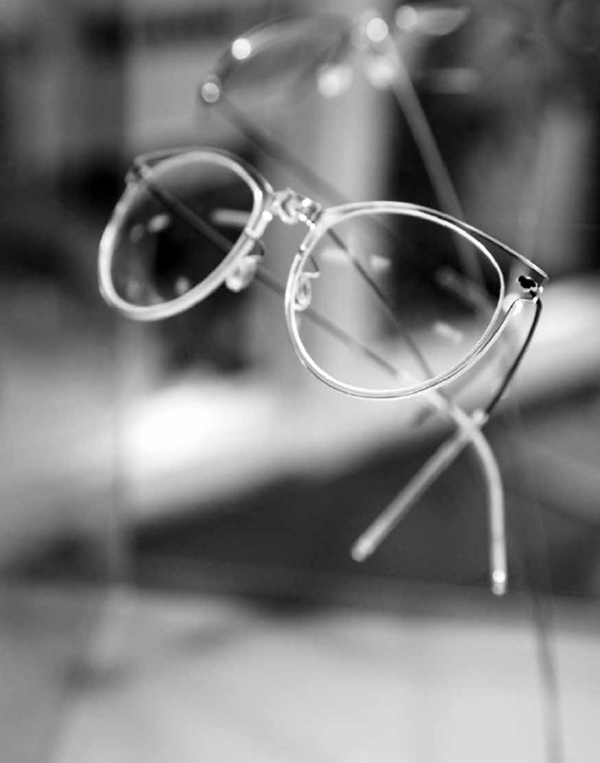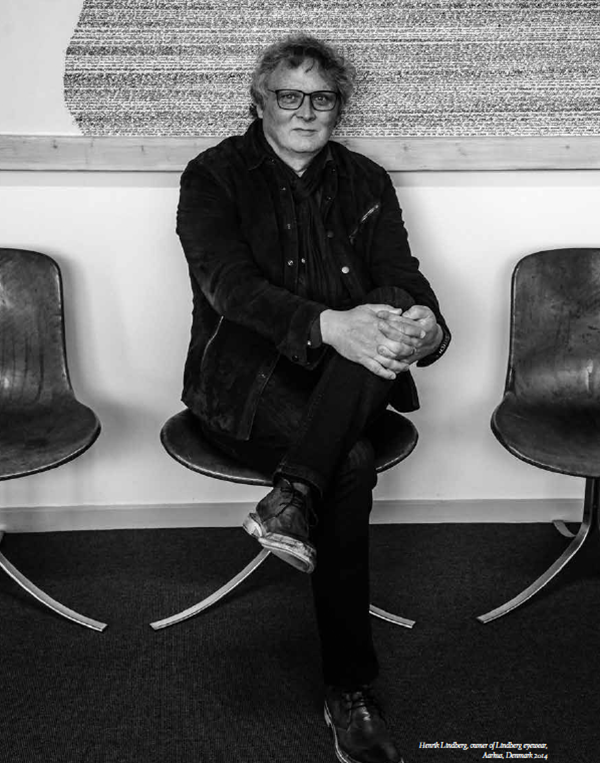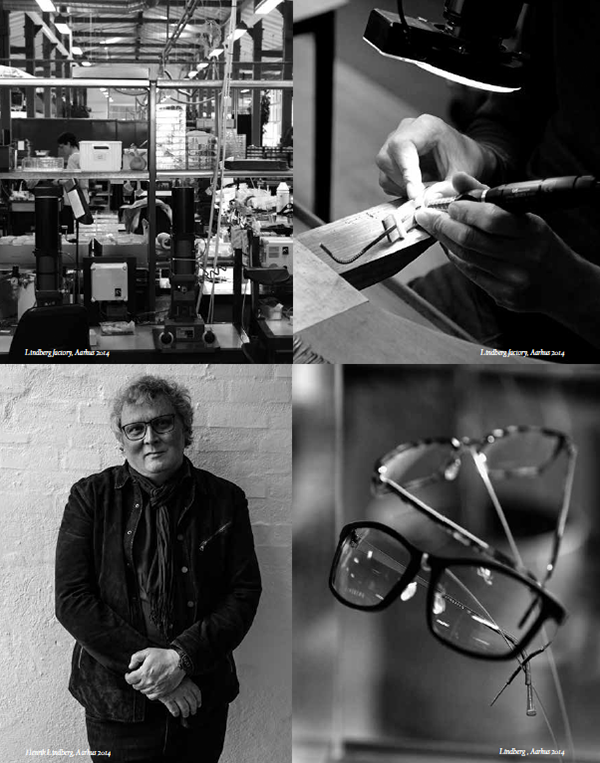Lindberg Eyewear
Interview and Photography by Mart Engelen
A conversation with Henrik Lindberg of Lindberg eyewear, owner of the Danish brand that has been creating some of the most innovative glasses in the world for nearly three decades.
Lindberg Eyewear, Aarhus, Denmark 2014
Mart Engelen: How would you describe the LINDBERG brand?
Henrik Lindberg: LINDBERG is a small family-owned company which many years ago made the decision to not only design everything itself but also to manufacture everything itself. And, finally, to make things clearer also to sell everything itself directly to opticians worldwide. The eyewear world in general may look small but it is actually a very important world because what we do sits in the middle of people’s faces and it’s the first thing you notice. It is very much related to communication. Because first of all we communicate with our eyes and then maybe with our mouth, hands, whatever. And for us, being in the centre of the whole thing is very important. It is a matter of being related in a way to style or fashion, design, etc. but above all it’s related to comfort. The materials you use and the way you design, engineer and manufacture is very important. You
shouldn’t actually feel that you are wearing a LINDBERG. And it’s very important that you have a proper fitting. And that you
are working with materials that are totally non-allergic. It’s like a complete package. It’s very similar to a car—a sports car. It’s not enough just to have a nice design. Although of course if you are only showing it in a museum, it doesn’t matter. But if you have to wear a frame, it really has to be built for comfort. You are a good example. You are among the few people who can wear a frame which is a little bit tight because you have a good nose for a frame. The frame will still stay in place even if you do not have enough tension at the sides.
ME: So in fact we can say that LINDBERG is a perfectionist in tailor-made eyewear.
HL: We are very much into that. Actually, it is how LINDBERG started. The design of the very first product (the Air Titanium) is 27 years old. And it’s very clean. I don’t call it simple; simple is not the right word. It’s clean; it shows what it is. The basic idea was to make a frame that doesn’t disturb your face. That was our first target. The next thing was; it has to be light. And the third thing was; you should be able to play with the system. For instance, when you have so many different shapes and lengths of noses, etc, we need to have a sort of building system. It’s a little bit like Lego. When you combine all these details you can actually be very clear in many ways. You can just play with this system. The problem at first was not the frame material but the lens material at that time. The lenses were not so strong. They were made of a special kind of plastic. But the ‘good news’ was that a mineral lens spoilt the whole idea because it would be too heavy. The weight would be four times this modern one. When we were searching at the time, titanium suddenly came in from the side. It was not there at the very start. It came in after one year. That was the very first titanium frame on the market.
ME: It looks very nice.
HL: Yes, it is very good. We still make and sell it. It is a little bit like the old Leica and Contax cameras. We still have enthusiastic opticians and clients who first bought them many years ago and continue to use them. The problem today is that lens technology is much more advanced now. You can make lenses much thinner today with the same prescription. But if I
make the lens thinner, I lose stability in the frame. You need a basic thickness to keep the stability. This works a little bit in
the opposite direction to making a lighter frame. That’s why we developed our best selling collection; the Spirit collection,
which is a unique minimalistic design with a weight from only 2.3 grams.This design goes well in hand with the newest super
thin and durable lens types.
ME: Is it, in a way, an advantage to be a family business these days facing so many competitors that are run by stakeholders or shareholders?
HL: First of all, we are a small company. My parents retired many years ago and today the company is owned by my sister and me. She is an optometrist and looks after one shop, here in Aarhus. She takes care of the store and I take care of all this. That means I don’t have to ask her about everything. I can sit here with the management group and decide what will we do
tomorrow. Of course, my opinion may not be their opinion and I think it’s a real strength that we can do this instead of going to
a board, talking to them and meeting four times a year. They’ll want you to achieve a certain growth every year. As a company,
we actually want to go the other way, we want to grow but it has to be in the quality of the product.
Henrik Lindberg, owner of Lindberg eyewear, Aarhus, Denmark 2014
ME: So this lets you achieve the best quality?
HL: You know, I go for it all the way. My job is…well, I am the helicopter, I am the pain in the arse. I am in the middle and anybody can ask me anything. I am not familiar with the Dutch way of doing business but in Denmark there is a very short distance between the employees and the management.
ME: Will there ever be an end to innovation?
HL: No. There is always room for something. It may be related to your way of thinking. It may be related to the machinery you buy, or to new materials. We have just made an innovation. We didn’t come up with the invention but we just figured out how we could use it in a particular way to solve a lot of problems in the future. We always have to be out there looking at what’s going on. We are so lucky because our technical manager, who retired not long ago, now travels around the globe for us just to find new materials, new machinery, etc.
ME: Everybody talks about Danish design. Do you think LINDBERG is an example of that, for example in simplicity
and functionality?
HL: We are a result of what our parents taught us. When I was a child my parents didn’t have a lot of money but they bought furniture by Arne Jacobsen, etc. who made furniture for the co-ops. It has now become very expensive but at the
time it was affordable. The whole idea was to make it very functional, a little bit of the IKEA way of thinking. It had to
be affordable.
ME: If you compare LINDBERG eyewear to a car, what would be closer design-wise, a Porsche 911 or a Citroen DS?
HL: Could be either. I am in love with both. They have such an amazing functionality and design.
ME: What makes the Air Titanium line so iconic for you? Can you put it in three words?
HL: I would say: Invisible, comfort and possibilities
ME: What do you mean by possibilities?
HL: I mean the building system. You can create whatever you want. You can make it visible or invisible, tiny or big, you can make it for a two-year-old but also for someone who is a hundred years old.
ME: What can you tell about a person who wears LINDBERG glasses?
HL: It’s a person who really wants to take care of him or herself. Who first of all has a good appreciation of comfort. But also of unique design and high quality.
ME: Can you have comfort without high quality?
HL: Of course. There is some very cheap, plastic stuff on the market. You can buy them at gas stations. They are quite light so you have a certain kind of comfort. They won’t solve your problem, but they can help you. It’s like trying to keep warm: you have forgotten your coat but you have a blanket. (ha ha)
ME: Has LINDBERG’s philosophy stayed the same through the years?
HL: It’s still the same. If you want to do it, do it 100 %! Otherwise forget it. And do as much as possible yourself — then you can control everything. Look at the slogan on the wall: Designed by LINDBERG and made by LINDBERG. Meaning: we want to control the whole process. You see this when you walk around, it’s like seeing a lot of small factories in one factory.
ME: What is the main difference between LINDBERG and other eyewear brands?
HL: Look at a single LINDBERG frame. All the frames we have can be customised. If you take an ordinary frame, it
looks like it is; so it might not fit your nose, etc. Everything is fixed. You can’t change it. Also, opticians love to work with
LINDBERG because, as an optician, you have to be a little bit cleverer technically.
ME: You built up the company from scratch with your father. What do you think was the most important virtue you learned from him?
HL: The keyword is innovation. My father was very innovative. When I was a child he was also designing frames in teak. It was the easiest way to work because you didn’t have machinery for acetate or metal. He was constantly working with the materials and the design. Always thinking how to improve, how to make things better. Engineering is very important for LINDBERG.
ME: Where do you see LINDBERG in ten years from now?
HL: If I knew that I would not be sitting here now. I would be doing something else. The eyewear business is very tough. Nowadays the big manufacturers are also buying up shops. That brings many changes and it will be more difficult in the
future. Luckily we deal directly with opticians. We have no distributors. No matter where you live in the world you have
access to any frame or model you like. With a distributor, it’s a different story.
Lindberg Factory, Aarhus 2014



